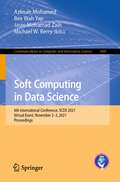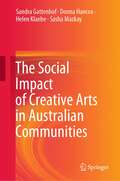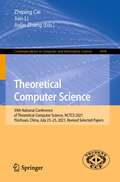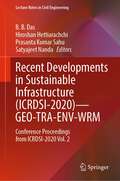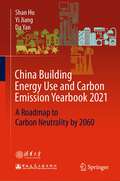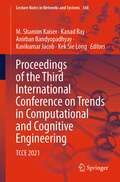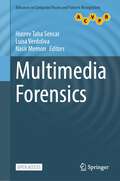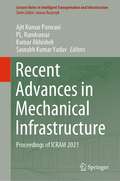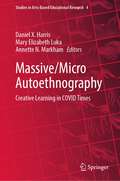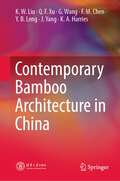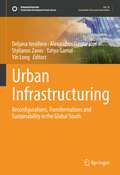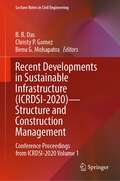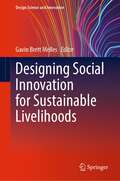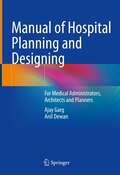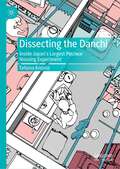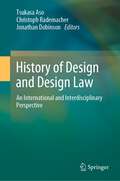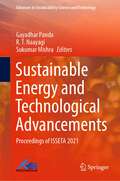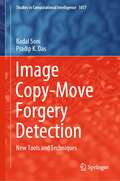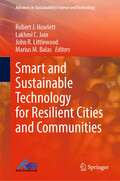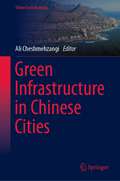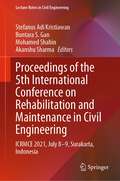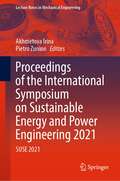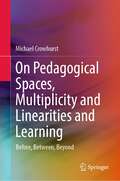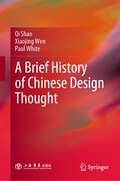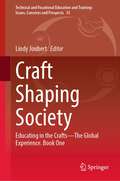- Table View
- List View
Soft Computing in Data Science: 6th International Conference, SCDS 2021, Virtual Event, November 2–3, 2021, Proceedings (Communications in Computer and Information Science #1489)
by Azlinah Mohamed Bee Wah Yap Jasni Mohamad Zain Michael W. BerryThis book constitutes the refereed proceedings of the 6th International Conference on Soft Computing in Data Science, SCDS 2021, which was held virtually in November 2021. The 31 revised full papers presented were carefully reviewed and selected from 79 submissions. The papers are organized in topical sections on AI techniques and applications; data analytics and technologies; data mining and image processing; machine & statistical learning.
The Social Impact of Creative Arts in Australian Communities
by Sandra Gattenhof Donna Hancox Helen Klaebe Sasha MackayThis book brings together discussions about Australian arts policy and funding, outcomes of arts engagement in terms of social inclusion, well-being and education. It presents exemplars of creative programs or case studies that build capacity and lasting impact for communities in urban and regional Australia. This book describes the impact of the arts using narrative case studies. Through this, it develops conceptual understanding and frameworks that can be used to dynamically assess the value and impact of arts engagement across the three types of cultural value: intrinsic value, instrumental value and institutional value. It focuses on how arts engagement creates, supports and extends factors such as well-being, social inclusion and educational achievement. This book provides an innovative examination of the evidence from Australian projects depicting the impact of the arts on a range of indicators and sectors.
Theoretical Computer Science: 39th National Conference of Theoretical Computer Science, NCTCS 2021, Yinchuan, China, July 23–25, 2021, Revised Selected Papers (Communications in Computer and Information Science #1494)
by Zhiping Cai Jian Li Jialin ZhangThis book constitutes the thoroughly refereed proceedings of the 39th National Conference of Theoretical Computer Science, NCTCS 2021, held in Yinchuan, China, in July 2021. The 67 full papers were carefully reviewed and selected from 145 submissions, and 14 of them were selected for the volume. The papers present recent research in the areas of information hiding, data detection and recognition, system scheduling, time series prediction, and formal analysis.
Recent Developments in Sustainable Infrastructure: Conference Proceedings from ICRDSI-2020 Vol. 2 (Lecture Notes in Civil Engineering #207)
by B. B. Das Hiroshan Hettiarachchi Prasanta Kumar Sahu Satyajeet NandaThis book includes selected papers from the International Conference on Recent Developments in Sustainable Infrastructure (ICRDSI-2020) and consists of themes pertaining to geotechnical engineering, transportation engineering, environmental engineering and water resources management.
China Building Energy Use and Carbon Emission Yearbook 2021: A Roadmap to Carbon Neutrality by 2060
by Shan Hu Yi Jiang Da YanDouble carbon targets have been one of the most motivations and targets for China’s social and economic development. Building is one of the most important sectors to achieve energy savings and emission reductions. This book focuses on China’s building energy usage and CO2 emissions, discusses the status quo of China’s building energy of four categories, their characteristics and technologies to improve energy efficiency and achieve zero-carbon emissions. Specifically, this book in 2021 discussed the pathways to achieve carbon neutrality targets for China’s building sector. This book also analyzed the energy mix, energy intensity, and technology perspectives to implement energy and carbon targets in urban residential building areas. This book consists of large-scale survey data, monitoring data and case studies. The discussion on technologies and policies is supported by a variety of evidence and continuous research for more than ten years. The information, data and policy suggestions will interest readers all around the world who work in energy, climate change, engineering and building science areas.
Proceedings of the Third International Conference on Trends in Computational and Cognitive Engineering: TCCE 2021 (Lecture Notes in Networks and Systems #348)
by Kanad Ray Anirban Bandyopadhyay M. Shamim Kaiser Kavikumar Jacob Kek Sie LongThis book presents various computational and cognitive modeling approaches in the areas of health, education, finance, environment, engineering, commerce, and industry. It is a collection of selected conference papers presented at the 3rd International Conference on Trends in Cognitive Computation Engineering (TCCE 2021), hosted online by Universiti Tun Hussein Onn Malaysia (UTHM) during October 21–22, 2021. It shares cutting-edge insights and ideas from mathematicians, engineers, scientists, and researchers and discusses fresh perspectives on problem solving in a range of research areas.
Multimedia Forensics (Advances in Computer Vision and Pattern Recognition)
by Husrev Taha Sencar Luisa Verdoliva Nasir MemonThis book is open access. Media forensics has never been more relevant to societal life. Not only media content represents an ever-increasing share of the data traveling on the net and the preferred communications means for most users, it has also become integral part of most innovative applications in the digital information ecosystem that serves various sectors of society, from the entertainment, to journalism, to politics. Undoubtedly, the advances in deep learning and computational imaging contributed significantly to this outcome. The underlying technologies that drive this trend, however, also pose a profound challenge in establishing trust in what we see, hear, and read, and make media content the preferred target of malicious attacks. In this new threat landscape powered by innovative imaging technologies and sophisticated tools, based on autoencoders and generative adversarial networks, this book fills an important gap. It presents a comprehensive review of state-of-the-art forensics capabilities that relate to media attribution, integrity and authenticity verification, and counter forensics. Its content is developed to provide practitioners, researchers, photo and video enthusiasts, and students a holistic view of the field.
Recent Advances in Mechanical Infrastructure: Proceedings of ICRAM 2021 (Lecture Notes in Intelligent Transportation and Infrastructure)
by Ajit Kumar Parwani Pl. Ramkumar Kumar Abhishek Saurabh Kumar YadavThe book presents latest research-based innovations in the field of mechanical infrastructure presented in the International Conference on Recent Advances in Mechanical Infrastructure (ICRAM 2021). The broad research topics presented in this book are recent advances in thermal infrastructure: This includes aerodynamics, renewable energy, computational fluid dynamics, carbon dioxide capture and sequestration, energy and thermo-fluids, fluid dynamics, fuels and combustion, heat and mass transfer, internal combustion engine, and refrigeration and air conditioning. Recent advances in manufacturing infrastructure includes green manufacturing, instrumentation and control, material characterization, manufacturing techniques, rapid prototyping, polymers, and composites. Recent advances in infrastructure planning and design includes applied mechanics, bio-mechanics, computer-aided engineering design, finite element analysis, industrial tribology, machine design, robotics and automation, dynamics and vibration, industrial engineering, and optimization.
Massive/Micro Autoethnography: Creative Learning in COVID Times (Studies in Arts-Based Educational Research #4)
by Daniel X. Harris Mary Elizabeth Luka Annette N. MarkhamThis book presents the creative, arts-based and educative thinking resulting from a “21 day autoethnography challenge” set of self-guided prompts arising from the large-scale collaborative, creative, and global project to explore Massive and Microscopic Sensemaking during COVId-19 Times. It employs a guiding methodological framework of critical autoethnography, narrating the macro and micro experiences of COVID-19 from a first-person, and critically, culturally-informed perspective. The book features chapters creatively responding to the 21-day pandemic experiment through digital autoethnographic artworks, writings, and collaborations. It allowed authors to build embodied sensibilities, practice autoethnographic forms of writing and making, and transform personal experiences through the COVID-19 moment into critical understanding of scale, sense-making, and the relationality of humans, nonhumans, and the planet.
Contemporary Bamboo Architecture in China
by K. W. Liu Q. F. Xu G. Wang F. M. Chen Y. B. Leng J. Yang K. A. HarriesThis book describes the distribution of bamboo forest and bamboo species for construction, the types and characteristics of both engineered and natural full-culm bamboo materials for construction, the development history and research status of different forms of bamboo architecture. We go on to describe standards, relevant international organizations, research institutions and production and processing enterprises and typical cases. Starting from six aspects, this book systematically describes modern bamboo building development, analyzes the opportunities and challenges faced by the bamboo construction industry and provides guidance for the development of the bamboo construction industry in China. Particularly in Chapter 6, more than 70 examples constructed mostly since 2014 are selected to provide a detailed overview of the use of bamboo as decorative and structural materials. In order to fully explore the potential of bamboo in engineering applications, the authors introduce the use of bamboo construction for transportation facilities (bridges, highway landscape fences and bus stations), landscape, water pipelines and urban municipal tunnels. The authors hope readers are inspired by these most vivid cases and experience the charm of modern Chinese bamboo architecture.
Urban Infrastructuring: Reconfigurations, Transformations and Sustainability in the Global South (Sustainable Development Goals Series)
by Deljana Iossifova Alexandros Gasparatos Stylianos Zavos Yahya Gamal Yin LongThis book is about urban infrastructuring as the processes linking infrastructural configurations and their components with other social, ecological, political, or otherwise defined systems as part of urbanisation and globalisation in the Global South. It suggests that infrastructuring is essential to urbanisation and that it is entangled with socio-spatio-ecological transformations that often have negative outcomes over time. Furthermore, it argues that infrastructuring requires an ethical positioning in research and practice in order to enhance infrastructural sustainability in the face of intersecting environmental, social and economic crises. “Urban Infrastructuring” is developed in three parts. First, it identifies infrastructural entanglements across various urban and urbanising settings in the Global South. Second, it highlights some of the damaging processes and outcomes of urban infrastructuring and argues that the absence, presence and transformation of infrastructure in the Global South (re-)produces socioecological injustice in the short- and long term. Third, the book argues for a shift of infrastructuring agendas towards more just and sustainable interventions. It suggests that an ethico-politics of care should be embedded in systems approaches to infrastructuring in both research and practice. The edited volume contains contributions from authors with backgrounds in a variety of academic disciplines from the natural and social sciences, engineering and the humanities. It provides valuable insights for anyone concerned with the study, design, planning, implementation and maintenance of urban infrastructures to enhance human well-being and sustainability. It will be of interest to researchers and urban decision-makers alike.
Recent Developments in Sustainable Infrastructure: Conference Proceedings from ICRDSI-2020 Volume 1 (Lecture Notes in Civil Engineering #221)
by B. B. Das Christy P. Gomez Benu G. MohapatraThis book includes selected papers from the International Conference on Recent Developments in Sustainable Infrastructure (ICRDSI-2020) and consists of themes pertaining to structural engineering and construction technology and management.
Designing Social Innovation for Sustainable Livelihoods (Design Science and Innovation)
by Gavin Brett MellesThis volume discusses how design broadly understood as design of business, policy, product, system, etc. can produce socially responsible innovations with livelihoods consequences. Sustainable Livelihoods Framework (SLF) is a robust framework for analysing and measuring social impact for excluded populations and groups. This is illustrated with case studies from India, Sri Lanka, Bangladesh, Nepal by discussing how initiatives concerned with design in the broad sense have the potential to create sustainable livelihoods. This volume will be of interest to scholars and practitioners in Sustainable Development and Design.
Manual of Hospital Planning and Designing: For Medical Administrators, Architects and Planners
by Ajay Garg Anil DewanThis book is a one-stop resource on all the critical aspects of planning and designing hospitals, one of the most complex healthcare projects to undertake. A well-planned and designed hospital should control infection rate, provide safety to patients, caregivers and visitors, help improve patients' recovery and have scope for future expansion and change. Reinforcing these basic principles, guidance on such effective planning and designing is the key focus. Readers are offered insights into eliminating shortcomings at every stage of setting up a hospital which may not be feasible to rectify later on through alterations. Chapters from 1 to 12 of the book provide exhaustive notes on initial planning, such as detailed project reports, feasibility studies, and area calculation. Chapters 13 to 27 include designing and layout of all the essential departments/units such as OPD, emergency, intermediate care, diagnostics, operating rooms, and intensive care units. Chapters 28 to 37 cover designing support services like sterilization department, pharmacy, medical gas pipeline, kitchen, laundry, medical record, and mortuary. Chapters 38 to 48 take the readers through planning other services like air-conditioning and ventilation, fire safety, extra low voltage, mechanical, electrical, and plumbing services. Chapter 49 is for the planning of medical equipment. A particular chapter on "Green" hospital designing is included. This book is a single essential tabletop reference for hospital consultants, medical and hospital administrators, hospital designers, architecture students, and hospital promoters.
Dissecting the Danchi: Inside Japan’s Largest Postwar Housing Experiment
by Tatiana KnorozThe book is the first to explore the history and political significance of the Japanese public housing program. In the 1960s, as Japan's postwar economy boomed, architects and urban planners inspired equally by Western modernism and Soviet ideas of housing as a basic right created new cityscapes to house populations turned into refugees by the war. Over time, as Japan's society aged and the economy began to stagnate, these structures have become a burden on society. In this closely researched monograph on the conditions of Japanese housing, Tatiana Knoroz sheds unexpected light on the rise and fall of the idea of social democracy in Japan which will be of interest to historians, architects, and scholars of Asian economic modernization.
History of Design and Design Law: An International and Interdisciplinary Perspective
by Tsukasa Aso Christoph Rademacher Jonathan DobinsonFor the first time, this book provides an up-to-date history of product design and product design law covering 17 countries — Japan, Korea, China, Singapore, the United Kingdom, Germany, France, Italy, the Nordic countries (Denmark, Finland, Iceland, Norway and Sweden), Russia, the United States, Brazil and Australia — selected for their innovative or influential approach to design or design protection.Each country is the subject of two chapters — one on the history of design and the other on the history of design law — authored by experts in design and intellectual property (IP) law. This unique interdisciplinary approach explains why and how various national design protection systems (that can include design, copyright, trade mark, competition and civil laws) developed, making it an ideal book for students, researchers and lawyers. The book also serves as an international survey of different national policy and legal responses to historical developments and specific design and legal issues allowing readers to consider their advantages and disadvantages — and so is also recommended for policy and law makers, as well as organizations that administer IP rights. Topics include the subject matter of design protection; procedural and substantive requirements; design registration; infringement; and the overlap of design rights and other IP rights. The chapters on design history provide further context to the historical development of these legal concepts by considering major design movements, key designers and iconic designs and the current state of design. The chapters highlight the connected and often complementary relationship between the two histories, not only for each country, but at the regional and international level, often as a result of government policies, trade, colonialism, immigration and globalisation. Design and design practice continue to become more global and evolve with developments in technology. At the same time, design laws are not internationally harmonized and continue to develop at the national level, with a number of significant changes occurring in recent years. This timely book shows how the lessons of the past continue to inform the future direction of design and the legal systems developed to protect it.
Sustainable Energy and Technological Advancements: Proceedings of ISSETA 2021 (Advances in Sustainability Science and Technology)
by Gayadhar Panda R. T. Naayagi Sukumar MishraThis book contains selected papers presented at the First International Symposium on Sustainable Energy and Technological Advancements (ISSETA 2021), which was organized by the Department of Electrical Engineering, NIT Meghalaya, Shillong, India, during September 24–25, 2021. The topics covered in the book mainly focuses on the cutting-edge research domain with respect to sustainable energy technologies, smart building, integration, and application of multiple energy sources; advanced power converter topologies and their modulation techniques; and information and communication technologies for smart microgrids.
Image Copy-Move Forgery Detection: New Tools and Techniques (Studies in Computational Intelligence #1017)
by Badal Soni Pradip K. DasThis book presents a detailed study of key points and block-based copy-move forgery detection techniques with a critical discussion about their pros and cons. It also highlights the directions for further development in image forgery detection. The book includes various publicly available standard image copy-move forgery datasets that are experimentally analyzed and presented with complete descriptions. Five different image copy-move forgery detection techniques are implemented to overcome the limitations of existing copy-move forgery detection techniques. The key focus of work is to reduce the computational time without adversely affecting the efficiency of these techniques. In addition, these techniques are also robust to geometric transformation attacks like rotation, scaling, or both.
Smart and Sustainable Technology for Resilient Cities and Communities (Advances in Sustainability Science and Technology)
by Lakhmi C. Jain Robert J. Howlett John R. Littlewood Marius M. BalasThis book is a collection of extended versions of papers presented at the KES Covid-19 Challenge international summit. The book focusses on technological, economic, and social developments to combat the effects of global and local disasters as well as the ways in which the recovery from Covid can be used to build more resilient and sustainable communities, industry, and improve the environment. It also discusses the global challenges of human-influenced climate change. There are chapters on making cities and communities more resilient through energy self-sufficiency, food production, resilient housing and buildings, human health and intelligent systems e.g. for forecasting and prediction.
Green Infrastructure in Chinese Cities (Urban Sustainability)
by Ali CheshmehzangiSince 2014, and the start of the New-type Urbanization Plan (NUP), we see a turning point in the sustainability agenda of China. One of the main indicators is greening cities and the built environments, which will be covered holistically in this edited book. From the perspective of green infrastructure, in particular, the book approaches key areas of ‘forest city development’, ‘sponge city program’, ‘green roofing’, ‘nature-based solutions’, ‘urban farming’, ‘eco-city development’, etc. This is the first time that such important areas of research come together under the perspective of green Infrastructure. The results would be beneficial to policymakers, practitioners, and researchers in China and across the globe. The comprehensive set of findings from this book will benefit other countries, as we aim to highlight some of the best practices of the current age.The main aim of the book is to put together an excellent group of scholars and practitioners from the field, focusing on the topic of ‘Green Infrastructure in Chinese Cities’. In doing so, we aim to cover some of the key ‘best practices’ for sustainable urbanism. Divided into four parts, the book covers four key areas of (1) Policy Interventions, (2) Planning Innovation, (3) Design Solutions, and (4) Technical Integration. In doing so, we cover an array of best practices related to green infrastructures of various types and their impacts on cities and communities in China.We expect the book to be a valuable resource for researchers in the areas of sustainability, urbanism, urban planning, urban geography, urban design, geographical sciences, environmental sciences, landscape architecture, and urban ecology. The book covers essential factors such as policy, regulations, and programs (in Part 1), planning paradigms and their impacts on urban development (in Part 2), integrated design solutions that suggest sustainable urbanization progression (in Part 3), and technical knowledge that would be utilized for the future development of green infrastructure practices in China and beyond. Lastly, this edited book aims to provide a collaborative opportunity for experts and researchers of the field, who could contribute to the future pathways of sustainable urbanization of China. Lessons extracted from these contributions could be utilized for other contexts, which will benefit a wider group of stakeholders.
Proceedings of the 5th International Conference on Rehabilitation and Maintenance in Civil Engineering: ICRMCE 2021, July 8-9, Surakarta, Indonesia (Lecture Notes in Civil Engineering #225)
by Stefanus Adi Kristiawan Buntara S. Gan Mohamed Shahin Akanshu SharmaThis book is a collection of papers presented at the 5th International Conference on Rehabilitation and Maintenance in Civil Engineering (ICRMCE 2021), held in Surakarta, Indonesia. The papers are grouped into sequential themes representing the structure of this book: o Part 1: Factors affecting building and infrastructure performance o Part 2: Testing and inspection of existing building and infrastructure o Part 3: Protection, maintenance, repair, and retrofitting of building and infrastructure o Part 4: Maintenance management of building and infrastructure o Part 5: Service life modelling of building and infrastructure o Part 6: Hazard mitigation o Part 7: Sustainability aspect in civil engineering design, process, modelling, maintenance, and rehabilitation Postgraduate students, researchers, and practitioners specializing and working in the area of protection, maintenance, repair, and retrofitting of civil engineering infrastructures will find this book very useful.
Proceedings of the International Symposium on Sustainable Energy and Power Engineering 2021: SUSE 2021 (Lecture Notes in Mechanical Engineering)
by Akhmetova Irina Pietro ZuninoThis book comprises the proceedings of the International Symposium on Sustainable Energy and Power Engineering (SUSE) 2021. The contents of this volume focus on recent technological advances in the field of energy efficiency and green buildings, new construction materials and related technology, hydrogen and renewable energy, environmental aspects of the modern power industry, etc. The contents cover latest advances especially in digital transformation of society and economy of the energy sector, turbomachines and combined plants, intelligent energy systems. This volume will prove a valuable resource for those in academia and industry.
On Pedagogical Spaces, Multiplicity and Linearities and Learning: Before, Between, Beyond
by Michael CrowhurstThis book introduces a research method called ‘auto-teach(er)/ing-focused research,’ a research process that aims to document understandings generated by, and for the teacher when that teacher teaches or re-teaches a course. It demonstrates how this method is applied by the author/researcher within the pedagogical space that is the teaching of a course, one that has been taught numerous times by the author/researcher over many years. This book documents understandings about learning and teaching that have emerged within the pedagogical space that is the teaching of a course, and the pedagogical space that is the writing of a book. It explores the notion that pedagogical spaces are complex, and that subjects navigate and are produced within them in a multiplicity of ways. This book applies a research method that generates a knowledge product that research practitioners in a variety of settings might find useful to adopt or adapt.
A Brief History of Chinese Design Thought
by Qi Shao Xiaojing Wen Paul WhiteThis book introduces readers to the history of design thinking in pre-modern China. The content is structured according to successive dynasties, covering the seven major periods of the pre-Qin, Qin and Han, Wei and Jin, Sui and Tang, Song and Yuan, Ming, and Qing dynasties. Each chapter introduces the most representative individuals of the period and discusses their work and ideas in order to reveal the national and cultural features of the respective periods. A distinctive feature of cultural identity running through the long course of China’s historical development is the argument that actions are determined by ideas: Such a view can be found in long-standing thinking on art, design, and creativity. The book demonstrates that conscious design is the vital link between the ideas that constitute human cultures and the physical objects that make up their resulting material cultures. It is the attribute of design that defines what it is to be human and also produces the physical evidence of the evolution of Chinese civilization. The book reveals the integrated characteristics of Chinese culture and art and shows how both changing and recurring ideologies have influenced Chinese design practice since the ancient Shang and Zhou dynasties and how these forces have shaped the spirit and materiality of Chinese civilization. Design is the cornerstone that has made China one of the major contributors to human civilization throughout the thousands of years of its history.Given its focus, the book largely appeals to two main audiences: an academic readership of students and researchers interested in cultural studies and, a more general one, consisting of those interested in international comparisons and wishing to learn more about Chinese history, society, and culture. In order to appeal to both, the book is written in a clear and accessible language.
Craft Shaping Society: Educating in the Crafts—The Global Experience. Book One (Technical and Vocational Education and Training: Issues, Concerns and Prospects #35)
by Lindy JoubertThis book focusses on the role of craft as a continuing cultural practice and the revival of disappearing skills in contemporary society. It includes twenty-five essays by highly regarded artisans, academics, technologists, entrepreneurs, businesspeople, curators, and researchers from many countries representing a wide range of global craft traditions and innovations. The authors explain their professional practices and creative pathways with knowledge, experience, and passion. They offer insightful analyses of their traditions within their culture and in the marketplace, alongside the evolution of technology as it adapts to support experimentation and business strategies. They write about teaching and research informing their practice; and they explain the importance of their tools and materials in function and form of the objects they make. The essays reveal a poignant expression of their successes, disappointments, and opportunities. This book offers case studies of how artisans have harnessed the traditions of the past alongside the latest design technologies. The authors reveal how global craft is not only a vehicle for self-expression and creativity, but also for being deeply relevant to the world of work, community and environmental sustainability. The book makes the vital link between skills, knowledge, education, and employment, and fills a much-needed niche in Technical, Vocational Education and Training TVET.
